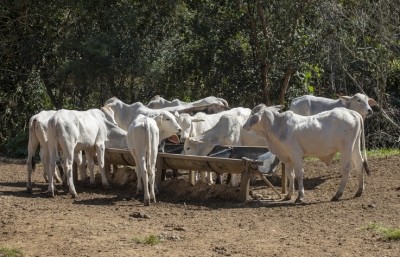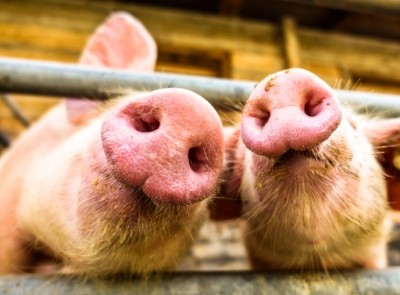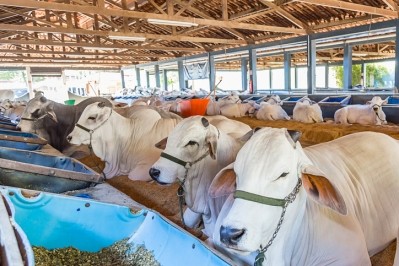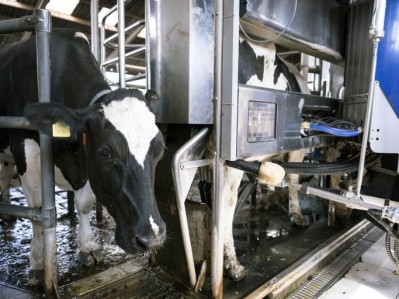Adding fat to pregnant cow diets may boost yield, performance
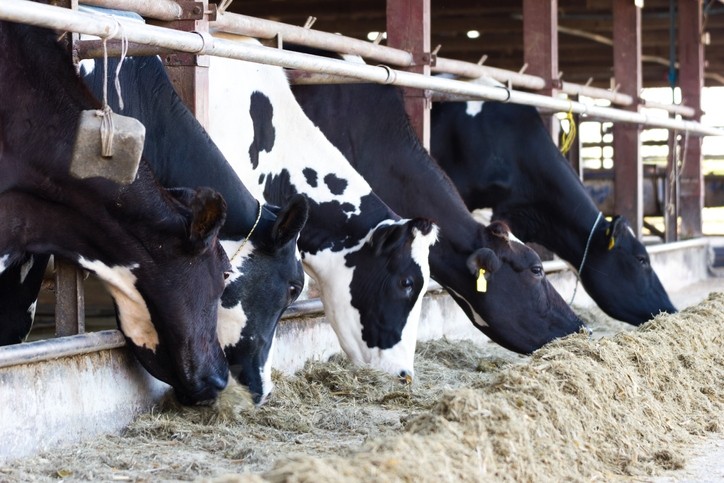
An international team of researchers from the University of Tehran and the Agricultural Sciences and Natural Resources University of Khuzestan in Iran and Kansas State University in the US explored the use and influence of select fatty acid salts in the diets of pregnant dairy cows. Group members published details about their work in the journal, Animal Feed Science and Technology.
“We hypothesized that feeding rumen-protected long chain FA during the last 3 weeks of gestation would enhance reproductive traits and production response of lactating dairy cows in their subsequent lactation,” the researchers said. “The objective was to evaluate the effect of supplementing rumen-protected n-3 and n-6 FA to Holstein dairy cows during the last 3 wk of pregnancy on the FA profile of colostrum and productive and reproductive responses from calving throughout the entire lactation.”
The researchers found that the supplements did not alter the amount of colostrum cows produced, but cows on the supplemented diets generated colostrum with more IgG. Fourteen weeks after parturition, cows on the trial diets had better body condition scores, higher milk yield, fat-corrected milk and milk fat levels.
Cows on the supplemented feeds also had a shorter period to first estrus and tended to have lower reproductive disorders, than those on the control diet, they said.
“Strategic supplementation of PUFA during the close-up period only, improved productive and reproductive performance in the subsequent lactation evaluated up to 300 d,” they added. “Prepartum supplementation of PUFA, during last 3 weeks of gestation, may be an effective strategy to increase the profitability of the dairy industry through improving productive and reproductive performance.”
Pre-lactation nutrition
When lactation starts, high-producing dairy cows increase the levels of nutrients needed to support milk production, the researchers said. Nutritional programs need to start during the dry period, especially the final three weeks, to support high levels of milk production, prevent disease incidence and support reproductive efficiency.
Supplemental fats may be added to lactating cow diets to boost energy density and energy balance in cows, they said. “Although the benefits of supplemental fat have been most commonly evaluated in lactating diets, more recently some studies have investigated the effects of supplemental fats during the dry and lactation periods,” they added.
Less has been done evaluating the use of supplemental long chain fatty acids (FA) during the “close-up” period prior to the start of lactation and the additives’ influence on lactation, they said.
Why supplemental n-3, n-6 fatty acids?
The essential role some fatty acids play in development has generated interest in exploring the potential “productive and reproductive benefits” of fatty acids on dairy cow performance, the researchers said.
“Fatty acids exert critical roles in different biological processes, one of the primary mechanisms is as a component of cell membranes providing stability and regulating signal transduction,” they said. Previous studies in humans and rats found that adding n-3, rather than n-6 fatty acids, are better at activating genes linked to lipid oxidation, encoding enzymes for lipid synthesis and regulating immune response.
Supplementing dairy cows with specific fatty acids has been linked to improved concentrations of the fatty acid along with its derivatives in plasma, milk and the endometrium, they said.
“A recent meta-analysis, which included 38 studies where 36 of them fed supplemental fat during the postpartum only, concluded that cows fed supplemental fat produced more milk ( + 1 kg/d) compared with cows fed diets without supplemental fat,” the researchers said. However, little work has been done looking at the use of supplemental fat prepartum, they added.
One study that assessed fat supplementation prepartum provided a rumen-protected fat – C16:0 and C18:0 –during weeks 8 to 4 and week 3 through parturition and reported poor results, they said. Dry matter intake prepartum feed, milk production in the first four weeks dropped and prepartum circulating non-esterified fatty acid increased.
However, supplementing diets high in C18:3n-3 rather than diets high in C18:2n-6 did not result in a drop in dry matter intake, they said. “Petit and Benchaar (2007) continued supplementing similar FA for ∼ 120 d postpartum and reported that cows fed flaxseed ate 9% more dry matter (DM), and although milk production or milk components were not affected by the type of FA, cows fed flaxseed had higher conception rate,” they added.
The results suggest that the influence of supplemental fat may differ depending on the fatty acid used and when the supplement is provided to cows, they said.
Feeding trial details
In the feeding trial, 120 non-lactating, pregnant dairy cows were given one of three diets for a three-week period prior to the anticipated date of calving, the researchers said. Cows were tracked from three weeks before calving through drying off but the different feeds were only given during the prepartum stage.
“The basal prepartum diet was formulated to have low concentrations of total FA, linoleic acid, and α-linolenic acid; thus fat supplements replaced corn ground in the control treatment,” they said. “Prepartum cattle were fed 1 of the following 3 diets: (1) no fat supplement (CON), (2) 1.15% of dietary DM as Ca-salts of soybean oil (CSO, 140 g/cow/daily) supplement, or (3) 1.15% of dietary DM as Ca salts of fish oil (CFO, 140 g/cow/daily) supplement.”
The fatty acid supplements used were commercially available, they said. During lactation, all cows ate the same diet.
Feed samples were collected weekly for analysis and average daily feed intake was calculated, they said. Colostrum weight was noted and samples were checked for fat, crude protein (CP), lactose, total IgG concentration and fatty acid profile.
Milk was sampled twice weekly and assessed for fat, protein and lactose along with somatic cell count, but only for the first 3 months, the researchers said. Cows were weighed and checked for body condition daily.
Blood samples were gathered on days 21, 14 and 7 prior to expected calving, after parturition and on weeks 3, 9 and 14 to “determine plasma concentrations of glucose, cholesterol, non-esterified FA (NEFA), triglycerides, blood urea nitrogen (BUN), total protein, albumin and insulin,” they said.
Following parturition, cows were examined for the expulsion of fetal membranes and scored for dystocia based on how much assistance was needed, they said. Cows also were checked for health and reproductive disorders including retained fetal membranes, metritis, inactive ovaries, ovarian cysts mastitis and dystocia.
At 30 days in milk, cows were started on a PreSynch/Ovsynch protocol, which involved a series of injections followed by artificial insemination for cows displaying signs of estrus, they said. Pregnancy was confirmed.
Results
Intake and colostrum yield and composition were similar for cows on all diets, the researchers said. However, the levels of IgG in colostrum were higher for cows on both supplemented diets.
“Similarly, C18:2n-6 and C20:2n-6 were higher in CSO-compared with CFO-fed cows,” they said. “The concentrations of C20:5n-3, C22:6n-3, C24:0 and C24:1 were only detected in colostrum from cows fed CFO.”
All cows had similar body weights and body condition scores (BCS) at three weeks to calving and nine weeks post-calving, but those on the supplemented diets tended to have better BCS at 14 weeks postpartum, they said.
“Prepartum fat supplementation increased milk yield during the entire lactation and improved reproductive performance,” they said. “Our findings suggest that the benefits of supplemental polyunsaturated FA during the prepartum period only is independent of the n-type of FA.”
Cows on the supplemented diets had increased milk yield for the entire lactation period, the researchers said. Milk protein and lactose concentrations did not differ among cows on different diets, but control group cows produced milk with higher fat levels.
“Despite the lower fat content in cows fed either calcium salts rich in n-6 or n-3, they had higher milk and FCM yields,” they added.
Cows on the supplemented diets had a higher fat yield during months 4 to 10 of lactation, they said. Protein and lactose yields also were higher for cows on the supplemented diets.
However, fat supplementation had little influence on plasma concentrations, they said. “Plasma cholesterol was higher in prepartum cows fed fat compared with CON, a similar effect was observed during the postpartum period,” they added.
Cows receiving the supplemented diets took fewer days to reach first estrus and tended to have fewer days open, they said. The percentage of pregnant cows tended to be lower for the control group.
“Although prepartum fat supplementation or type of supplemental FA did not influence pregnancy at first AI or 150 DIM, the proportion of pregnant cows by 250 DIM tended to be higher in both fat-supplemented groups compared with CON,” the researchers said.
Additionally, reproductive disorders tended to be higher in control group cows, but did not differ between cows on the supplemented diets, they said. Control group cows also had a higher incidence of all health disorders.
Source: Animal Feed Science and Technology
Title: Effect of supplementing calcium salts of n-3 and n-6 fatty acid to pregnant nonlactating cows on colostrum composition, milk yield, and reproductive performance of dairy cows
Authors: A. Jolazadeh, T. Mohammadabadi, M. Dehghan-banadaky, M. Chaji, M. Garcia
DOI: doi.org/10.1016/j.anifeedsci.2018.11.010
